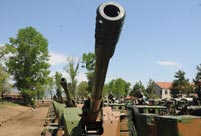

BEIJING, Jan. 28 -- No sector better symbolizes China's shift from a nation of labor intensive manufacturing to one that excels in the high-tech field, than high speed rail (HSR).
When the idea for a HSR network was raised over a decade ago, trains and supporting equipment had to be sourced from foreign companies, such as Japanese corporation Kawasaki, French firm Alstom and Germany's Siemens.
With its strategy of "introduction, digestion, absorption and innovation", China's domestic industry is now a roaring success. Its two domestic manufacturers, China North Railway (CNR) and China South Railway (CSR), now control the country's entire HSR market.
By 2014, just six years after the launch of China's first HSR passenger service, there was 16,000 km of tracks, connecting most major cities.
However, building more than half of the world's total HSR lines in ten years is just the beginning, as there are plans to add another 16,000 km of track by 2020.
Not just satisfied with domestic expansion, China has been ambitiously extending its influence beyond its borders.
Although a latecomer to the field, Chinese companies are now in a position to bid for, and win, major contracts in both emerging and developed countries.
According to German transportation consultant firm, SCI Verkehr, CNR and CSR currently hold the lion's share of the world's HSR market, with their sales revenue equal to the other five top companies combined.
Cost advantages and shorter delivery time have made Chinese HSR equipment more competitive than its counterparts, said Xu Zongxiang, CSR's vice president.
Xu said the domestic industry chain saw lower production costs while higher labor efficiency helped shorten delivery time for one train to 12 months, compared with between 18 and 22 months required by foreign manufacturers.
To further strengthen its competitive edge, a CNR and CSR merger is on the horizon. China Academy of Engineering academic Wang Mengshu said this would allow China to better concentrate on innovation.
In addition to promoting its HSR equipment and technology, China is also championing a global network and pushing forward construction.
Boosted by President Xi Jinping's Silk Road belt and road initiatives, China is currently in negotiations with 28 nations, most of which are along the trade route. Should discussions bear fruit, a network of over 5,000 km is on the cards.
The Silk Road economic belt and the 21st century maritime Silk Road are a land-based belt from China via Central Asia and Russia to Europe; and a maritime route through the Strait of Malacca to India, the Middle East and East Africa.
China is also considering another ambitious proposal, initially raised by Wang Mengshu, which would see a HSR line originating in Beijing that passes through Siberia, Alaska and Canada before reaching the U.S.
The China-U.S. trip would see a 200-km underwater tunnel constructed beneath the Bering Strait and the trip would take less than two days, according to Wang.
The project, which is technically feasible, demands serious negotiation among the nations concerned, not to mention substantial financial support, Wang said.
But China's HSR dream has not been without its setbacks. In November, Mexico annulled a deal of a Chinese built 210 km HSR line connecting Mexico City with the industrial hub of Queretaro to the north, the first time China would have built an entire HSR system overseas.
At home, a deadly crash in July 2011, which claimed 40 lives in east China, and a series of corruption cases have also cast a shadow over HSR expansion.
Despite these setbacks, China continues, full speed ahead.
 PLA soldiers operating vehicle-mounted guns in drill
PLA soldiers operating vehicle-mounted guns in drill Beauties dancing on the rings
Beauties dancing on the rings Blind carpenter in E China's Jiangxi
Blind carpenter in E China's Jiangxi Top 10 highest-paid sports teams in the world
Top 10 highest-paid sports teams in the world In photos: China's WZ-10 armed helicopters
In photos: China's WZ-10 armed helicopters UFO spotted in several places in China
UFO spotted in several places in China Certificates of land title of Qing Dynasty and Republic of China
Certificates of land title of Qing Dynasty and Republic of China  Cute young Taoist priest in Beijing
Cute young Taoist priest in Beijing New film brings Doraemon's life story to China in 3D
New film brings Doraemon's life story to China in 3D China-S.Korea FTA sets positive precedent
China-S.Korea FTA sets positive precedent Ferry carrying 458 people sinks in Yangtze River
Ferry carrying 458 people sinks in Yangtze River Mecca of Marxism
Mecca of Marxism Bring them home
Bring them homeDay|Week